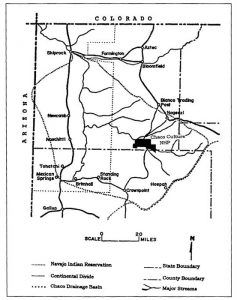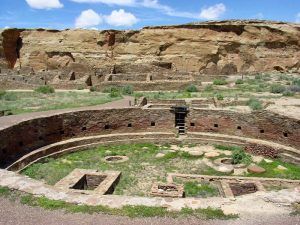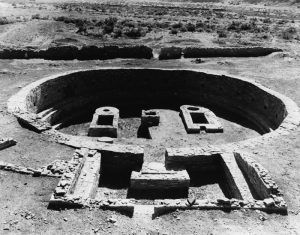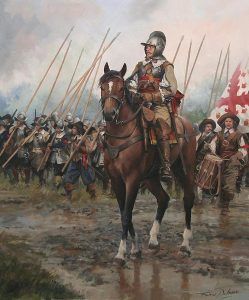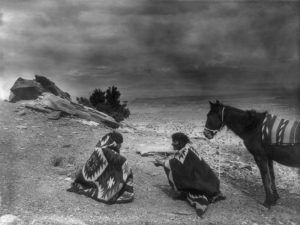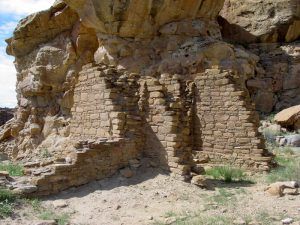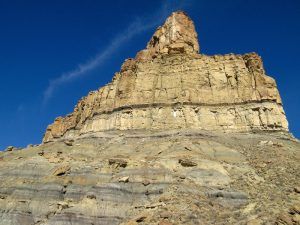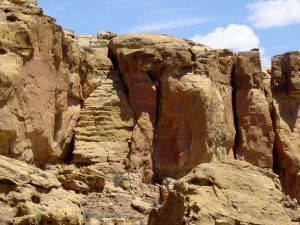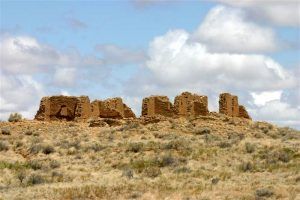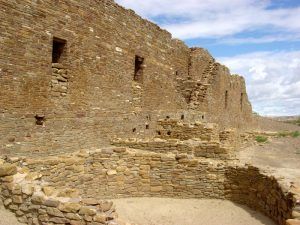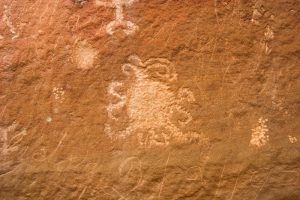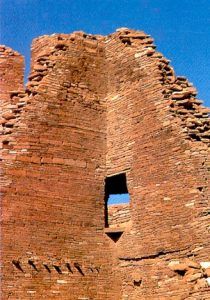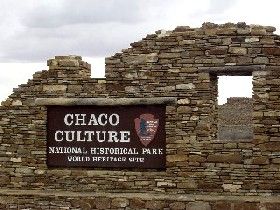
Chaco Culture National Historical Park
Preserving one of America’s most significant cultural and historic areas, the Chaco Culture National Historical Park is remarkable for its distinctive architecture, numerous ruins, and ancient roads. The remote and isolated park is located in northwestern New Mexico, between Albuquerque and Farmington, in a relatively inaccessible valley cut by the Chaco Wash.
Once home to the Ancient Puebloans, Chaco Canyon was a major center of ancestral Puebloan culture between 850 and 1250 A.D.
By 1000 A.D., the Chaco culture had firmly established a spiritual, political, and economic center serving the Four Corners area. It is estimated that the region was called home to as many as 5,000 people living in approximately 75 settlements scattered throughout the canyon.
In addition to its remarkable public and ceremonial buildings, the Ancient Puebloans built numerous roads, ramps, dams, and mounds, which required a great deal of well-organized and skillful planning, designing, resource gathering, and construction. The distinctive architecture combines several designs, astronomical alignments, geometry, landscaping, and engineering to create an ancient urban center that continues to amaze archeologists and visitors a thousand years later.
Archeological evidence suggests that the Ancient Puebloans had been occupying the area as early as 1200 B.C. when they survived as nomadic hunters and gatherers, hunting with wood clubs, hunting sticks, and spears. Some three centuries later, they began to make more permanent homes in caves and pit houses where they constructed numerous woven baskets covered with mud and baked to make waterproof containers. Archaeologists identify these first people as Basket Makers.
About 700 A.D., the Ancient Puebloans began cultivating crops, such as corn and squash, and building permanent dwellings. These small, one-storied, masonry structures were the beginning of what would become the great pueblos of the southwest.
Some two centuries later, as their population grew, the communities expanded into larger, more closely compacted pueblos. Around this time, the Pueblo Bonito complex was built, beginning with one curved row of rooms near the north wall. Continuing to refine their building techniques, the use of thick masonry walls and the generous use of mud mortar allowed walls to rise to more than four stories in height.
During this time, the Chacoans quarried sandstone blocks and hauled timber from great distances, assembling 15 major complexes that remained the largest buildings in North America until the 19th century. Many of these buildings are thought to have been aligned to capture the solar and lunar cycles, which would have required generations of astronomical observations and centuries of skillfully coordinated construction.
More pueblos, including Chetro Ketl, Una Vida, Penasco Blanco, Hungo Pavi, and Kin Bineola, were also started at about this time. Some large buildings show signs of being planned from the start, in contrast to the usual Ancient Puebloans custom of adding rooms as needed. For the next two centuries, more and more of these large pueblos with oversized rooms began to be built throughout the region. Eventually, there were an estimated 75 villages in the area, tied together by an extensive system of roads.
From the 12th to the 13th centuries, many of the pueblos in Chaco Canyon were abandoned when a long cycle of drought began in the San Juan Basin, beginning in about 1130. The Ancient Puebloans were at their height of civilization when the lack of rainfall led to food storage. Even though they had designed an extensive system of dams and irrigation methods, the dry climate and overtaxed fields could no longer support the immense population. As famine spread throughout the area, the people began to leave, joining other pueblos near the Little Colorado River and the Rio Grande.
Some archaeologists now believe that other factors, such as religious upheaval, internal political conflicts, and warfare, may have also contributed to the abandonment. By the 1300s, all of the villages and pueblos of Chaco Canyon were abandoned. As the ancient Indians left, their kivas were ceremonially burned, and most of their possessions were left behind.
Today, their descendants are members of 20 Indian tribes in New Mexico and Arizona, and many maintain their connections with Chaco today. These tribes include modern-day Pueblo Indians of New Mexico, the Hopi of Arizona, and the Navajo.
By the 1600s, the Navajo people primarily occupied the canyon. in 1680, the Pueblo Revolt against the Spanish briefly unified the Pueblo peoples of New Mexico and their neighbors. However, the Spanish returned in 1692 and re-conquered the area, which forced many of the Pueblo peoples into exile. Many of these people sought refuge with the Navajo people in Chaco Canyon and the surrounding area. These people intermarried and exchanged ideas.
1774 Don Bernardo de Miera y Pacheco identified the Chaco Canyon area as “Chaca” on a Spanish map, and in 1823 Jose Antonio Viscarra, the Spanish Governor of New Mexico led a military force west of Jemez Pueblo onto Navajo lands. He noted many Chacoan buildings along the route.
Colonel John M. Washington led the first American expedition into the area in 1849. During the trip, Lieutenant James Simpson of the Army Corps of Topographical Engineers surveyed Navajo lands and wrote reports of the Chacoan sites while the Kern brothers drew illustrations of the buildings. In 1877, artist and photographer William Henry Jackson, with the US Geological and Geographical Survey, produced expanded descriptions and maps of Chacoan sites and identified additional structures, including a stairway in the cliffs.
More expeditions and archeologists followed in the next decades. Chaco Canyon National Monument was established on March 11, 1907, by Theodore Roosevelt. In 1949, the University of New Mexico deeded lands in Chaco Canyon National Monument to the National Park Service in exchange for continued rights to conduct scientific research in the area. By 1959, the National Park Service had constructed the park visitor center, staff housing, and campgrounds. In the 1970s, several research projects, archaeological surveys, and limited excavations began, which provided extensive information about the ancient Ancient Puebloans.
Archeological excavations in Chaco Canyon today are limited, as modern methods such as remote sensing now allow archaeologists to gather a great deal of information without disturbing the fragile and irreplaceable sites.
In December 1980, an additional 13,000 acres were added to the park. The Park Service developed the multi-agency Chaco Culture Archaeological Protection Site program to protect Chacoan sites on adjacent Bureau of Land Management and Navajo Nation lands. The sites are part of the sacred homeland of Pueblo Indian peoples of New Mexico, the Hopi Indians of Arizona, and the Navajo Indians of the Southwest, all of whom continue to respect and honor them.
Chaco Canyon Sites:
The Ancient Puebloans built numerous great houses, kivas, and pueblos throughout a nine-mile stretch of the canyon floor, perched on mesa tops and situated in nearby drainage areas.
A nine-mile paved loop accesses five major Chacoan sites from the Visitor’s Center, where self-guiding trails are available. Trail guides are also available in the parking lots of the sites or the bookstore. Each site usually takes 45 minutes to one hour to complete.
Four backcountry hiking trails are also available to access more remote sites and features. Free permits can be obtained at the visitor center. The nine-mile loop and the Wijiji, Casa Chiquita, and Kin Klizhin trails may also be biked. Inquire at the visitor center for free permits and directions.
Casa Chiquita: This unexcavated village, located near the old north road to the canyon entrance, is thought to have been built around 1100 A.D. This village contains fifty rooms and three kivas, originally standing two or three stories high. A trail beginning at Casa Chiquita follows an old wagon road down the Chaco Wash leading to Peñasco Blanco. Along this trail, numerous rock art and historic inscriptions can be seen on the cliff face on the north side of the trail.
Casa Rinconada: On the south side of Chaco Wash, almost directly across from the Pueblo Bonito, stands the largest known great kiva in the park. The great subterranean kiva, with no surrounding residential or support structures, was once utilized for religious activities and ceremonies. Casa Rinconada one had thirty-nine-foot passageways from the underground structure to above-ground levels. The trail leading to the great kiva passes several villages.
Chetro Ketl: Located about 1/4 mile southeast of Pueblo Bonito, Chetro Ketl is one of the largest pueblos in Chaco Canyon. Construction of the pueblo is believed to have begun in 1020 A.D. and continued over the next three decades. The immense elevated earthen plaza, rising above the surrounding landscape, is estimated to contain 500 rooms and 12 kivas, including one great kiva within the central courtyard. The 500-foot long rear wall once supported five stories of rooms, the lower of which were utilized for storage, while the upper rooms contained living quarters. The walls are embedded with wooden beams, thought to have been carried from distant forests. The structure was abandoned by 1120. In the cliffs behind the ruin are ancient stairways that lead to prehistoric roadways to Pueblo Alto and other outlying communities.
Fajada Butte – Rising some 400 feet above the canyon floor, Fajada Butte is visible for miles at the entrance of Chaco Canyon. High atop the imposing butte is a set of spiral petroglyphs carved into the cliff face behind three giant slabs of rock. Functioning as a solar marker, a vertical shaft of light pierced the main spiral at its center. The site, known as the Sun Dagger, was discovered by Anna Sofaer in 1977, who conducted an extensive investigation and published results showing how the spirals may have tracked the lunar cycle. Unfortunately, in 1989, the rock slabs shifted, and the effect was ruined. The rooms, thought to have been used by Chacoan astronomers, was also a place of worship. The loss of the sun dagger prompted the World Monuments Fund Chaco Culture National Historical Park to its Most Endangered Monuments list in 1996. Today, the site is closed to visitors.
Hungo Pavi: “Reed Spring Village” is located just about a mile from Una Vida at the junction of Chaco and Mockingbird Canyons. Thought to have been built around 1000 A.D., the medium-sized pueblo contained some 73 ground-floor rooms, two kivas in the structure that reached four stories in height. It lies at the base of a prehistoric stairway that leads up the mesa and an ancient road linking it to the Chacoan road system.
Kin Kletso: Located about 1/2 mile west of Pueblo Bonito, Kin Kletso was built in two phases between 1125 and 1130 A.D. by people who came to Chaco Canyon from the Northern San Juan Region. The walls were made of large-shaped sandstone blocks laid two or more rows thick. The medium-sized pueblo called the “Yellow House” by the Navaho contains around fifty-five ground-level rooms, four kivas, and a tower kiva. Excavated in the early 1950s, evidence of an obsidian production industry was found here.
Kin Nahasbas: This isolated great kiva was constructed during the middle 1000’s. Nestled against the North Mesa, the ruins are located just north of Una Vida.
New Alto or Nuevo: Located just east of Pueblo Alto, the Pueblo was one of the latest ones constructed in the late 1100s. Despite a decrease in the population in the rest of the canyon, the pueblo contained some 28 rooms and a kiva. It is speculated that it may have been built by Indians who had migrated from the Mesa Verde area.
Peñasco Blanco: Blanco, Spanish for “white cliff,” is a large arc-shaped great house built in five different stages, between 900 and 1125 A.D. One of the first large pueblos built in the canyon, the ruins display the development in Chacoan masonry through the centuries. Sitting atop the northernmost point of West Mesa, the pueblo overlooks the confluence of the Chaco and Escavada Washes. Reaching up to four stories tall, the pueblo contained approximately 160 ground-floor rooms, two great kivas in the central plaza, and two more located outside the pueblo. Near Peñasco Blanco is a well-known cliff painting that contains a crescent moon, a ten-pointed star, a handprint, and a sun sign. Catching the attention of astronomers, many have speculated that the pictograph represents the sighting of a supernova in July 1054 A.D. or the appearance of Halley’s comet in 1066 A.D.
Pueblo Alto: Located on a mesa flat due north of Pueblo Bonito, this great house is thought to have been built between 1020 and 1050 A.D. Serving the area residents as a community house, archeological evidence suggests periodic episodes of occupancy and feasting. It has been estimated that only five of the 85 rooms were constructed for permanent residents, while the others were utilized for community events and industry, including bead and turquoise processing and chert tool production. Ancient stairs lead from the large pueblo to the top of the mesa.
Pueblo Bonito: This D-shaped pueblo is the largest Great House in the park spanning nearly two acres and believed to have once been as tall as five stories. The approximately 650 rooms surrounded the central plaza, and throughout the settlement were about 40 kivas and numerous meeting places that served ceremonial purposes. The pueblo was occupied from the mid-800s to the 1200s, with about 1,200 people at its height. Pueblo Bonito is one of the most extensively excavated and studied sites in North America and is considered sacred by many Native American groups.
Pueblo del Arroyo: Located near Pueblo Bonito at the side drainage known as South Gap, the pueblo was built in stages over a relatively short time. The central portion was built around 1075 with the north and south wings, the plaza, and the tri-walled structure built in the early years of the 12th century. The building once boasted approximately 280 rooms and more than 20 kivas.
Tsin Kletzin: Dating back to the early 1100s, Tsin Kletzin is located on the south mesa top above Casa Rinconada. The unexcavated great house lies near a large earthenware structure known as the Weritos Dam, where it is believed the ancient Ancient Puebloans obtained water. Because Tsin Kletzin has two roads leading to it from the north but no roads continuing southward, it is thought that it served as a destination point.
Una Vida: This Chocaon public building, closest to the Visitor’s Center, was one of the earliest constructed, beginning sometime in the mid-800’s. Construction is believed to have continued on the great house up until the late 1000’s. Una Vida includes approximately 150 rooms and five kivas. The great house was known to the Navajo as “witchcraft woman’s house” due to its association with a well-known legend where a witch held hostages atop Fajada Butte without food or water. On the cliff face behind Una Vida is an Ancient Puebloans pictograph that displays humanoid and geometric forms and four-legged animal shapes, possibly big horned sheep.
Wijiji: With just over 100 rooms, Wijiji is the smallest to the great houses, thought to have been built around 1110 A.D. Located in a narrow wash about a mile from Una Vida, the site appears to have been utilized in part as a calendrical station.
Because of the aridity and remoteness of the San Juan Basin, Chaco’s record of evolving complexity is almost unrivaled in its preservation. It continues to testify to the organizational and engineering abilities not seen anywhere else in the American Southwest.
Today, Chaco Canyon is a UNESCO World Heritage Site, and some locations are off-limits to the public due to erosion and because they are considered sacred ancestral homelands by the Hopi and Pueblo people.
The National Historical Park also provides guided tours, hiking & biking trails, camping, and night sky programs. The park is situated on the Trails of the Ancients Byway, one of the designated New Mexico Scenic Byways.
Chaco Canyon is located in northwestern New Mexico. The preferred and recommended access route to the park is from the north, via US 550 and County Road 7900, and County Road 7950. From the north, turn off US 550 at CR 7900, three miles southeast of Nageezi and approximately 50 miles west of Cuba (at mile 112.5). This route is clearly signed from US 550 to the park boundary (21 miles). The route includes five miles of paved road (CR 7900) and 16 miles of rough dirt road (CR 7950).
All sites and trails are open from sunrise to sunset.
Contact Information:
Chaco Culture National Historical Park
PO Box 220
Nageezi, New Mexico 87037-0220
505-786-7014
© Kathy Weiser-Alexander/Legends of America, updated July 2021.
Also See:
Ancient & Modern Pueblos – Oldest Cites in the U.S.
National Parks, Monuments & Historic Sites
Pueblo Indians – Oldest Culture in the United States
Sources:
Chaco Culture National Historical Park
Chaco Research Archive
Wikipedia

